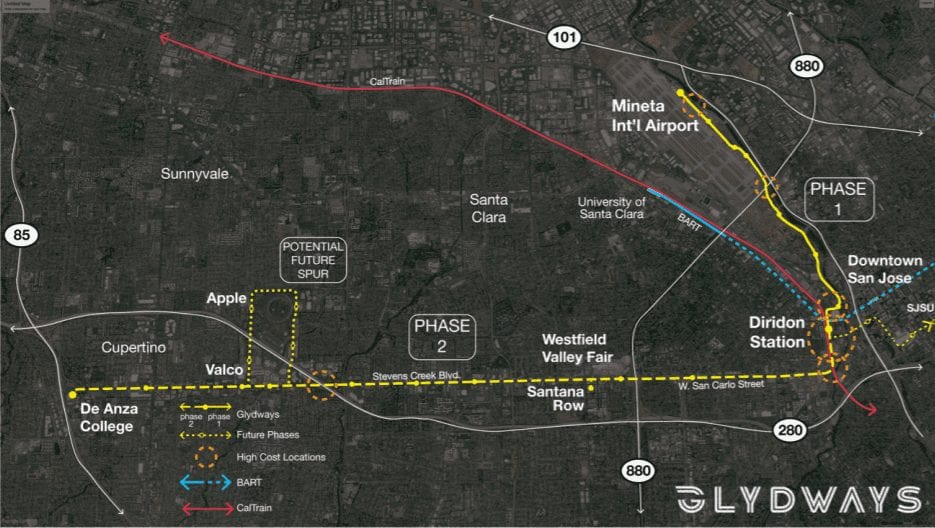Driverless vehicles zooming through underground tunnels and electric mini trains could be in San Jose’s future.
City leaders voted unanimously on Aug. 25 to advance projects connecting Diridon Station, Stevens Creek Corridor and the Mineta San Jose International Airport. Councilmember Maya Esparza was absent.
Many of the proposals — including one from Elon Musk’s The Boring Company — feature self-driving cars or automated shuttles that will bring high-tech transportation to Silicon Valley.
The city received 23 proposals, which aim to embrace green technology and increase transportation access for residents, according to Ramses Madou, manager of the city’s planning, policy and sustainability division.
Mayor Sam Liccardo said city leaders must be innovative when considering San Jose’s future.
“Silicon Valley isn’t going to fail because there’s a recession,” Liccardo said. “Silicon Valley is going to fail if we stop looking to the future and we stop thinking about how we’ll invest in the future …. That will be our downfall. We absolutely have to do this.”
Connecting Stevens Creek Corridor in Cupertino and the airport to Diridon Station in the heart of downtown San Jose would provide travelers with easier access to BART and Caltrain services, according to the city’s transportation department.
“The private car system is a little bit at its max for not-in-COVID times,” Madou told the San José Spotlight on Aug. 25. “All the highways are totally clogged and people with lower incomes are spending an immense amount of time in their cars to get to and from work.”
However, some critics said Silicon Valley needs to focus on improving its existing transit system — which has been hit hard by COVID-19 — before creating “fancy” new technologies.
“It’s pretty insulting you’re considering an airport connector — another expensive capital project — when we’re about to really suffer,” said transportation advocate Monica Mallon.
In February 2019, the City Council told staff to investigate the various technologies available for building new public transportation.
Tunnels containing self-driving Teslas, pod-shaped monorail vehicles and a Plenary Glydways fleet of autonomous electric vehicles operating on existing roads are among some of the ideas being considered.

The cost of creating these new systems could range from $60 million to $4.3 billion, according to Madou’s report to the City Council.
Liccardo and councilmembers agreed the city’s current travel lines, including light rail and bus service, are not up to par.
“We’re talking about these state of the art transportation solutions connecting an area like Cupertino into downtown San Jose, and meanwhile, as the mayor pointed out, we have an outdated and not very well-functioning transit system connecting South and North San Jose,” Councilmember Raul Peralez said. “Unfortunately the connection to East San Jose is still lacking in one portion and that is actually where the (Bus Rapid Transit) is.”
Peralez also expressed concerns that access is still limited because residents in San Jose would have to take other busses and light rail to the airport connector instead of riding a direct line.
Alex Shoor, executive director of Catalyze SV, remains optimistic.
“Although VTA has some great options for bus transit along Stevens Creek, we know we can do better and we need to do better to allow that growth in District 6,” Shoor said. “We are excited that the city is considering these options.”
It’s unclear whether the projects will use private or public funds, but councilmembers recommended exploring private options.
Councilmember Lan Diep was “enthused” about the concept of a public-private partnership.
“I’m still all in on the idea,” Diep said, suggesting the city could successfully monetize the project to increase public benefits while letting a private company invest and build.
In 2000, Santa Clara County voters passed Measure A, implementing a 30-year tax to connect Diridon Station to the airport, bring BART to San Jose and make other transportation improvements.
Private funding could allow the project to move more quickly, according to Madou.
“If we can get a system like this built with private money and we can put conditions on that system that would meet most of the public needs — particularly around equity and access — that project would probably happen faster than it would, in terms of us needing to wait for 15 years or so to kind of cobble all the money together through the various public processes,” Madou said.
A report exploring the legality and pricing of private options will be due by August 2021.
“It’s going to be a heavy lift, but I have a lot of confidence that the team we put together and the individuals who have come together to pursue this vision are going to move forward and accomplish something,” Vice Mayor Chappie Jones said. “Right now, we’re starting out by putting all options on the table, looking at all possibilities and then narrowing in on a final solution.”
Contact Carly Wipf at [email protected] or follow @CarlyChristineW on Twitter.



Leave a Reply
You must be logged in to post a comment.